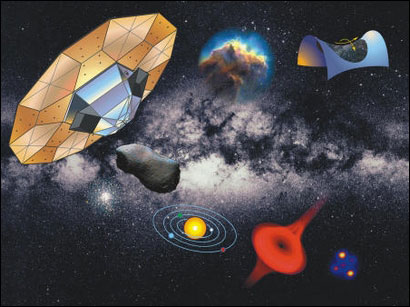| Feb 12, 2013 |
Gaia mission will reveal the secrets of ultra-cool dwarfs
|
|
(Nanowerk News) Among the hundred billion stars which can be observed in the Milky Way, there is a group of stars, the so-named ultra-cool dwarfs, defined as stars with a temperature below 2500 K, which includes ultra-cool dwarfs and brown dwarfs. It is a really interesting group: they are the most ancient objects in our Galaxy and, therefore, they can provide information about its primitive chemical composition. This is one of the objectives of Gaia mission which will be launched at the end of 2013 by the European Space Agency.
|
 |
| Artist's impression of Gaia and its scientific goals.
|
|
When observing them, they seem quite similar, but there are clear differences between brown dwarfs and ultra-cool dwarfs: brown dwarfs do not reach the temperature they need to produce the nuclear reactions which characterize ultra-cool dwarfs. It could be said that brown dwarfs are failed stars because they lack mass.
|
|
A study published on the journal Astronomy & Astrophysics ("Properties of ultra-cool dwarfs with Gaia"), led by the National University of Distance Education (UNED) and in which researchers from the Institute of Cosmos Sciences of the University of Barcelona (ICCUB) participated, has developed a method that will allow Gaia to detect tens of ultra-cool dwarfs in the Milky Way. The method to estimate physical parameters of these objects, such as temperature or gravity, has also been validated. Researchers have used data mining techniques to make estimations taking into account the parameters that Gaia can measure and its design characteristics. This method highly improves the accuracy of data, so the estimation of ultra-cool dwarfs’ temperature will have a little margin of error. This improvement in accuracy will also increase considerably the number of ultra-cool dwarfs detected. However, only few tens of those which show a temperature lower than 1500K and weak bright in the wavelengths observed by Gaia could be detected.
|
|
The National University of Distance Education, the Astrobiology Center (CSIC-INTA), the University of Cádiz, and the German-Spanish Calar Alto Observatory participate in the research too.
|
|
Gaia mission
|
|
Gaia will conduct a census of a thousand million stars in our Galaxy, monitoring each of its target stars about 70 times over a five-year period. It will precisely chart their positions, distances, movements, and changes in brightness. The launch of the satellite, currently on trial, will take place at the end of 2013, on a Soyuz-Fregat rocket. During this period of time, it is expected to discover hundreds of thousands of new celestial objects. Gaia instruments are so precise that, if it was on the Earth, it would be able to measure the thumb of a person who is on the Moon’s surface.
|
|
Gaia will provide information about different parameters (position, speed, distance, physical properties, etc.) for each object, so a map of our Galaxy will be obtained.
|
|
Gaia mission will generate more than one petabyte of information, in other words, one million giga, which will have to be processed and analysed in order to get results.
|
|
About 400 scientists collaborate in the project in which thirty researchers and technicians from the Department of Astronomy and Meteorology of the UB and from the ICCUB had an important role in creating and designing the instrument, as well as in processing and simulating the data obtained during the mission.'
|

